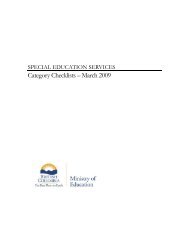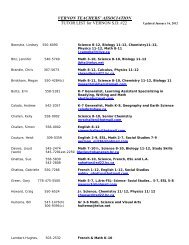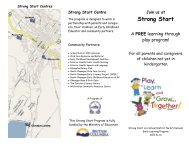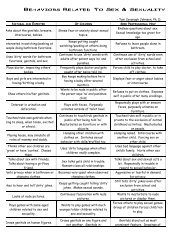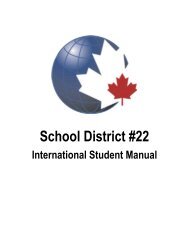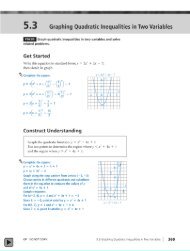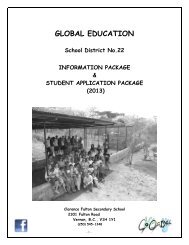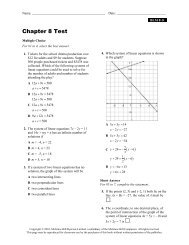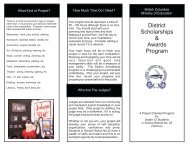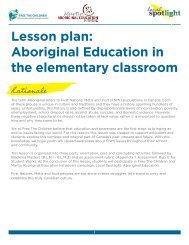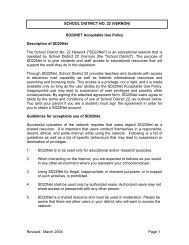My Name is Seepeetza
My Name is Seepeetza
My Name is Seepeetza
You also want an ePaper? Increase the reach of your titles
YUMPU automatically turns print PDFs into web optimized ePapers that Google loves.
A NOVEL STUDY<br />
1
Novel Study Project<br />
Th<strong>is</strong> novel study project was developed by the Regional Vancouver Island<br />
Aboriginal Circle with the help of the Aboriginal Education Branch at the<br />
Min<strong>is</strong>try of Education.<br />
Special thanks to Lou<strong>is</strong>e Spencer for her contributions.<br />
The goal of the novel study project was to create lessons incorporating<br />
Aboriginal literature and/or Aboriginal authors, while keeping in mind, the<br />
Aboriginal learner.<br />
In order to best meet these goals the lessons were designed to:<br />
• Respect the cultures of Aboriginal and non-Aboriginal people who may<br />
read and participate in theses lessons.<br />
• To use a non-linear approach<br />
• To provide mix and match strategies that may be applied to many texts<br />
• To use graphic organizers whenever possible to accommodate the<br />
inclusion of a diversity of learners<br />
• To provide opportunities to integrate Engl<strong>is</strong>h and Social Studies<br />
• To include elements of writing, inquiry , collaboration and reading in<br />
each lesson<br />
• To provide a set of question that can be used as prompts for d<strong>is</strong>cussion<br />
groups, journaling activities, comprehension or evaluation<br />
2
Teacher Reference Sheet<br />
<strong>My</strong> <strong>Name</strong> <strong>is</strong> <strong>Seepeetza</strong><br />
A novel by: Shirley Sterling<br />
ISBN 0-88899-165-7<br />
NOVEL SUMMARY<br />
Th<strong>is</strong> <strong>is</strong> a story about the life of a twelve year old girl in a residential school during<br />
the late 50’s in Kalamak, Brit<strong>is</strong>h Columbia. It compares her life at school and at<br />
home and encourages the reader to think about where she should have grown<br />
up, and the methods and quality of her learning between the two different cultures.<br />
Grade level: Th<strong>is</strong> book <strong>is</strong> appropriate for the grade 7 or 8 level. The vocabulary<br />
<strong>is</strong> not difficult but the content may be upsetting to learn about and so should be<br />
approached with sensitivity.<br />
ABOUT THE AUTHOR<br />
Born in Merritt, B.C., Shirley was a member of the Interior Sal<strong>is</strong>h Nation of<br />
Brit<strong>is</strong>h Columbia. She earned a Bachelor of Education and a doctorate on oral<br />
traditions and the transm<strong>is</strong>sion of culture. She wrote <strong>My</strong> <strong>Name</strong> Is <strong>Seepeetza</strong>,<br />
which <strong>is</strong> based on her own childhood experiences at an Indian residential<br />
school. Acclaimed in both Canada and the United States, the book has won<br />
the Sheila A. Egoff Children’s Literature Prize. She also won the Laura<br />
Steiman Award for Children’s Literature.<br />
Themes explored in the novel<br />
• Residential Schools<br />
• Catholic<strong>is</strong>m<br />
• Persecution<br />
• Power of Family<br />
• Home <strong>is</strong> best<br />
• Loneliness<br />
• Compassion<br />
• Bullying<br />
RECOMMENDED GRADE LEVEL: 8 AND UP<br />
3
Student Handout<br />
<strong>My</strong> <strong>Name</strong> <strong>is</strong> <strong>Seepeetza</strong><br />
Pre-reading Activity<br />
Decide whether you agree or d<strong>is</strong>agree with the following statements:<br />
1) <strong>Name</strong> calling doesn’t do that much damage.<br />
Agree D<strong>is</strong>agree<br />
2) People should be able to choose their given name.<br />
Agree D<strong>is</strong>agree<br />
3) Your name <strong>is</strong> the first gift your parents give you.<br />
Agree D<strong>is</strong>agree<br />
4) Your name partly determines your personality.<br />
Agree D<strong>is</strong>agree<br />
5) It doesn’t matter how others spell your name<br />
Agree<br />
D<strong>is</strong>agree<br />
6) Changing your name <strong>is</strong> no ones business but your own.<br />
Agree<br />
D<strong>is</strong>agree<br />
7) <strong>Name</strong>s are not meaningul, just a way to identify people.<br />
Agree D<strong>is</strong>agree<br />
4
Student Handout<br />
5
Teacher Reference Sheet<br />
STUDENT ACTIVITY 1: One Pager<br />
Goal: To help students v<strong>is</strong>ualize what they are reading and to help<br />
them choose important quotes.<br />
Rationale: One-pagers are helpful for students because they are encouraged<br />
to graphically represent an element of the plot. They are also<br />
encouraged to choose important quotes and to form a personal response<br />
to the personal quotes.<br />
Steps:<br />
1. Explain the rationale for one-pagers.<br />
2. Explain the requirements and give students the handout below.<br />
STUDENT ACTIVITY 2: Quick Write<br />
Quickwrite<br />
<strong>My</strong> <strong>Name</strong> <strong>is</strong> <strong>Seepeetza</strong><br />
Sorting Out Emotion<br />
Directions<br />
1) L<strong>is</strong>t three things that make you happy.<br />
2) “Say Something” strategy around the room. Each person says one thing<br />
that makes them happy. Read diary entry Thursday Sept. 18, 1958<br />
(pages 14-16) and Sept. 25 1958 (pages 16-19)<br />
3) Rate the following quotes as either positive (+) or negative (-). Then go<br />
back and identify the emotion.<br />
6
Student Handout<br />
STUDENT ACTIVITY 1: One Pager<br />
A One-Pager <strong>is</strong> a way of responding to a piece of writing on a single sheet of<br />
paper. It represents your own written and graphic interpretation of what you<br />
have read. It may be very literal (just based on the facts or information in the<br />
piece) or it may be a symbolic representation of the piece. It helps you as a<br />
reader to v<strong>is</strong>ualize what you are reading.<br />
Directions:<br />
Must be on standard sized, unlined paper<br />
Must fill the entire page<br />
Writing must be in ink or typed...no pencil<br />
Include the title and the author of the piece<br />
Use coloured pens or markers unless the piece demands black and white<br />
The following required elements may be arranged on the page in any way you<br />
choose:<br />
1. Must have two or more excerpts from the reading. (Passages that you<br />
like or think are important).<br />
2. Must have a graphic representation: drawing, magazine picture, or<br />
computer graphic that ties to the piece you read and the quotes you<br />
chose.<br />
3. Must include a personal response to what you have read: comment,<br />
interpretation, evaluation, etc.<br />
7<br />
AVID Center, 2002, reproducible for classroom use.
Student Handout<br />
Quote Response (Rate and Identify Emotion)<br />
“I like journals because I love writing<br />
whatever I want.” (pg 11)<br />
“That’s when my s<strong>is</strong>ters M<strong>is</strong>sy and I sometimes<br />
hold hands as we walk down the hall. It’s the<br />
happiest part of my day”<br />
“ I told Cookie I want to write secret journals for<br />
one year…I’ll get in trouble if I get caught”<br />
“S<strong>is</strong>ter Theo checks our letters home. We’re not<br />
allowed to say anything about school. I might get<br />
the strap or worse.”<br />
“I don’t like school. We have to come here every<br />
September and stay until June.”<br />
“<strong>My</strong> dad doesn’t like it either but he says it’s the<br />
law. All status Indian kids have to go to residential<br />
schools”<br />
“We get to go home in the summer, at Chr<strong>is</strong>tmas,<br />
sometimes at Easter.”<br />
“ Last year some boys ran away because the<br />
priest was doing something bad to them. The<br />
boys were caught and whipped.”<br />
“ We started joking and laughing like Mum<br />
and Auntie Mamie and Yay-yah do when<br />
they’re cleaning berries or f<strong>is</strong>h together at<br />
home.”<br />
“One time when my dad was putting up the<br />
hay we had all our wagons and tents in a<br />
circle…We used logs rolled over as benches.<br />
There was lots of talking and laughing, most<br />
of it in Indian.”<br />
“After that S<strong>is</strong>ter Maura asked me what my<br />
name was. I said, my name <strong>is</strong> <strong>Seepeetza</strong>.<br />
Then she got really mad like I did something<br />
terrible…She told me if I had a s<strong>is</strong>ter to go<br />
and ask what my name was.”<br />
<strong>My</strong> <strong>Name</strong> <strong>is</strong> <strong>Seepeetza</strong><br />
STUDENT ACTIVITY 2: Dual Entry Diary<br />
8
Teacher Reference Sheet<br />
<strong>My</strong> <strong>Name</strong> <strong>is</strong> <strong>Seepeetza</strong><br />
STUDENT ACTIVITY 3: Favourite Places<br />
Complete the following writing activity on Healthy Emotions, taken from<br />
First Nations Young People: Becoming Healthy Leaders.<br />
9
Student Handout<br />
<strong>My</strong> <strong>Name</strong> Is <strong>Seepeetza</strong><br />
STUDENT ACTIVITY 4: Favourite Places<br />
1) Four Corners - Choose the corner that best suits your choice of a favourite<br />
place. Go to that corner.<br />
Near Water Near Trees or Mountains<br />
Other<br />
In a Busy Place In a Building<br />
2) In your corners, l<strong>is</strong>t on a chart, the reasons why people in your group like a<br />
place such as th<strong>is</strong> and specifically, what each person’s place <strong>is</strong> like. Think<br />
about your senses. Talk about the kind of place you v<strong>is</strong>ualize.<br />
3) Read pages 22-24 Thurs. Oct. 9, 1958 .<br />
4) Write about your favourite place, silently.<br />
10
Student Handout<br />
<strong>My</strong> <strong>Name</strong> <strong>is</strong> <strong>Seepeetza</strong><br />
STUDENT ACTIVITY 5: Crime and Pun<strong>is</strong>hment<br />
Quickwrite: What rules would you have for your own children and teenagers<br />
if you were the parent?<br />
Group Activity:<br />
Look at the l<strong>is</strong>t of pun<strong>is</strong>hments in your group. Rate each pun<strong>is</strong>hment as either<br />
:<br />
FAIR UNFAIR CRUEL<br />
Pun<strong>is</strong>hment: fair unfair cruel<br />
1) whipped with a willow branch<br />
2) head shaved<br />
3) boys made to wear dresses<br />
4) kneeling for extended periods of time<br />
5) kneeling and watching others eat<br />
6) fed only bread and water<br />
7) people encouraged to laugh at offender<br />
8) hit on palms with a leather strap<br />
9) threatened the devil upon the offender<br />
10) being called names<br />
11
Teacher Reference Sheet<br />
<strong>My</strong> <strong>Name</strong> <strong>is</strong> <strong>Seepeetza</strong><br />
STUDENT ACTIVITY 5: Crime and Pun<strong>is</strong>hment<br />
Writing in your groups:<br />
In your groups, make a l<strong>is</strong>t of offenses mentioned in the story.<br />
Writing on your own:<br />
Write a letter to <strong>Seepeetza</strong>’a teachers telling them better ways to handle<br />
d<strong>is</strong>cipline. Be the voice of the students. Provide ways that the school could<br />
have helped the students learn instead of trying to change them. Convince<br />
them that you are right.<br />
Consider the following questions:<br />
What types of ways do adults handle d<strong>is</strong>cipline and pun<strong>is</strong>hment these days?<br />
How should adults teach their children?<br />
Why did the school try to change them?<br />
Why did the school not want the kids to write home?<br />
Why did the adults abuse the children?<br />
Why did they push their own religion on the Aboriginal people?<br />
1) Looking at the opposite sex<br />
2) Speaking own language<br />
3) Talking to friends<br />
4) Stepping out of line<br />
5) Wetting the bed<br />
6) Writing in secret<br />
7) Telling parents about school<br />
8) Answering anything other than ‘yes or no’<br />
9) Running away<br />
10) Telling when abused by an adult<br />
12
Student Handout<br />
<strong>Seepeetza</strong><br />
Student Activity 6: Sorting Life Events<br />
DIRECTIONS: Cut apart the quotes and sort the events into <strong>Seepeetza</strong>’s two<br />
different lives - one at home and one at school. Where do you believe <strong>Seepeetza</strong><br />
could have learned better?<br />
These are examples of Aboriginals and m<strong>is</strong>sionaries approached education.<br />
Sort the quotes on a T- chart.<br />
“Today my dad saddled up the horses and took me and Benny and M<strong>is</strong>sy up the<br />
mountain to Cody Canyon. He wanted to clear the creek that flows down from the<br />
beaver pond into our hayfields. Dad wants to get one more hay crop th<strong>is</strong> fall.”<br />
(page 123)<br />
“After a while somebody started a bonfire and people lined up to play lahal, the<br />
stick game.” (page 123)<br />
“ Us kids went around the back of the house to watch men carving our Aunt<br />
Alice’s name on the wood headstone. The wood shavings smelt nice like the pine<br />
sap that we eat in the early spring.”<br />
“Benny and M<strong>is</strong>sy rode Da<strong>is</strong>y, Mum’s old saddle horse. Maybe Dad wanted to see<br />
how M<strong>is</strong>sy would handle Da<strong>is</strong>y on her own.”<br />
“Mum said her grandmother, Quaslametko, didn’t want her and her brothers and<br />
s<strong>is</strong>ters to go to school, because school would turn them into white people. They<br />
wouldn’t be able to hunt or f<strong>is</strong>h or make baskets or anything useful anymore.”<br />
“At school we get up at six o’clock every morning.”<br />
“ As soon as the s<strong>is</strong>ter rings the bell we kneel on the floor and say prayers.”<br />
“ After mass we put our smocks over our uniforms and line up for breakfast…”<br />
“After breakfast we have jobs to do like clean the lavatories or dust the hall or<br />
sweep the stairs.”<br />
“Mr Oiko teaches catech<strong>is</strong>m, composition, spelling and arithmetic in the morning,<br />
and science, socials and art in the afternoon.”<br />
13
Student Handout<br />
<strong>My</strong> <strong>Name</strong> <strong>is</strong> <strong>Seepeetza</strong><br />
STUDENT ACTIVITY 6: Sorting Life Events<br />
Home<br />
School<br />
14
Teacher Reference Sheet<br />
<strong>My</strong> <strong>Name</strong> <strong>is</strong> <strong>Seepeetza</strong><br />
STUDENT ACTIVITY 7: Comparing Characters to Self<br />
1) Quickwrite : What chores should teenagers do? Why? Which ones should they not do?<br />
Why not?<br />
2) Read to find the school chores and the home chores that <strong>Seepeetza</strong> and her peers had<br />
to do. (pages 11-19) Make notes on post-it notes to use later for your Venn diagram.<br />
3) In groups of four, compare your l<strong>is</strong>ts and add your peers’ ideas to your l<strong>is</strong>ts.<br />
4) Use the Venn Diagram to compare chores of today’s teenagers to those of <strong>Seepeetza</strong>’s<br />
chores in the 1950’s. Use your chores and your peers’ chores for “chores now-a-days”<br />
Label the Venn diagram with either: Now vs Then or Chores Today vs Chores in 1950’s<br />
5) Write a letter to parents of the world about what should be expected from a teenager.<br />
Consider these questions to help you with your writing.<br />
What can your parents expect from you?<br />
What did your parent’s parents expect from them?<br />
What do your friend’s parents expect from them?<br />
What did <strong>Seepeetza</strong>’s parents expect from her?<br />
What did <strong>Seepeetza</strong>’s teachers expect from her and her peers?<br />
Are everyone’s expectations fair and real<strong>is</strong>tic?<br />
Or:<br />
Write a response to today’s reading.<br />
Which chores do you all do?<br />
Which chores do you prefer?<br />
Who has the worst jobs?<br />
Were the chores the same as they are today? Why or why not?<br />
15
Student Handout<br />
<strong>My</strong> <strong>Name</strong> <strong>is</strong> <strong>Seepeetza</strong><br />
STUDENT ACTIVITY 7: Comparing Characters to Self<br />
Venn Diagram<br />
<strong>Name</strong>: ____________________________<br />
Date: _____________________________<br />
Differences Similarities Differences<br />
16
Teacher Reference Sheet<br />
<strong>My</strong> <strong>Name</strong> <strong>is</strong> <strong>Seepeetza</strong><br />
STUDENT ACTIVITY 7: Writing about Character<br />
Quickwrite:<br />
1) Ask students to complete an “I am” poem about themselves. They do not<br />
have to use every sentence stem.<br />
2) Read aloud and have the students complete Nine Squares activity by<br />
drawing about <strong>Seepeetza</strong>’s character. Ask them to l<strong>is</strong>ten to dialogue, her<br />
thoughts, actions and think of her personality traits.<br />
3) Individually complete an “I am” poem about <strong>Seepeetza</strong>.<br />
17
Student Handout<br />
“I Am” Poem<br />
Student example of an “I am” poem written during a unit on MIA soldiers during<br />
Vietnam War<br />
I am the young son of a pilot who’s m<strong>is</strong>sing in action.<br />
I wonder if he had time to bail out.<br />
I hear my mother talking on the telephone.<br />
I see the somber faced uniformed v<strong>is</strong>itor in the living room.<br />
I am the young son of a pilot who’s m<strong>is</strong>sing in action.<br />
I pretend he’s home in the kitchen or out in the yard.<br />
I feel weak and alone.<br />
I touch h<strong>is</strong> shoes and h<strong>is</strong> books on the shelf.<br />
I worry that I’ll never know if he’s alive or dead.<br />
I cry when I realize that he won’t be home next week.<br />
I am the young son of a pilot who’s m<strong>is</strong>sing in action<br />
I understand that he went to war.<br />
I say he will come back.<br />
I dream of h<strong>is</strong> voice.<br />
I try to imagine other pilots and soldiers.<br />
I hope they find my father.<br />
I am the young son of a pilot who’s m<strong>is</strong>sing in action.<br />
18
Student Handout<br />
<strong>My</strong> <strong>Name</strong> <strong>is</strong> <strong>Seepeetza</strong><br />
STUDENT ACTIVITY 8: Understanding Character<br />
Writing:<br />
Use the following template to write an “I am” poem about <strong>Seepeetza</strong>.”<br />
I am<br />
I wonder<br />
I hear<br />
I see<br />
I am<br />
I pretend<br />
I feel<br />
I touch<br />
I worry<br />
I cry<br />
I am<br />
I understand<br />
I say<br />
I dream<br />
I try<br />
I hope<br />
I am<br />
19
Student Handout<br />
<strong>My</strong> <strong>Name</strong> <strong>is</strong> <strong>Seepeetza</strong><br />
STUDENT ACTIVITY 8: Understanding Character<br />
Nine Squares<br />
Storyboard for:<br />
___________________________________________________________<br />
20
Student Handout<br />
<strong>My</strong> <strong>Name</strong> <strong>is</strong> <strong>Seepeetza</strong><br />
Template for Reading Response Logs<br />
(Do not turn th<strong>is</strong> sheet in. The information below should be copied into your<br />
reading response logs each week.)<br />
Title:<br />
________________________________________________________________<br />
Author:<br />
______________________________________________________________<br />
Page: ______________ to page _____________<br />
Summary: (4-6 sentences). Retell what you remember reading th<strong>is</strong> week.<br />
Response: (12-15 sentences)<br />
Possible ways to begin a response:<br />
Th<strong>is</strong> connects to my life in th<strong>is</strong> way...<br />
I wonder...<br />
Th<strong>is</strong> <strong>is</strong> important because...<br />
I don’t understand _____ because_____...<br />
I want to remember th<strong>is</strong> _____ because _____...<br />
Quote a passage and then respond to it.<br />
Record thinking that informs the way you want to live your life,<br />
21<br />
Do I Really Have to Teach Reading?
Student Handout<br />
<strong>My</strong> <strong>Name</strong> <strong>is</strong> <strong>Seepeetza</strong><br />
STUDENT ACTIVITY 9: Response Logs<br />
Throughout the novel <strong>Seepeetza</strong> frequently demonstrates strategic thinking,<br />
thinking that includes making a plan, setting goals and developing strategies.<br />
At the end of your response include five sticky notes each containing a quote<br />
that demonstrates <strong>Seepeetza</strong>’s strategic thinking. Be sure the page number<br />
<strong>is</strong> written on each sticky note and adhere them to the page.<br />
Points for each piece:<br />
One point per page read, up to 25 pages.<br />
Ten points for a well-written summary.<br />
Fifteen points for a thoughtful response.<br />
Ten points for five sticky notes that demonstrate strategic thinking.<br />
22
Teacher Reference Sheet<br />
<strong>My</strong> <strong>Name</strong> <strong>is</strong> <strong>Seepeetza</strong><br />
STUDENT ACTIVITY 10: Creating a Mandala for <strong>Seepeetza</strong><br />
1) Refer to the Circle “Healthy Well-Balanced Life”.<br />
D<strong>is</strong>cuss the four types of health.<br />
2) Show the Circle of W<strong>is</strong>dom. (Why circles?)<br />
3) Have the students brainstorm in groups about how well balanced<br />
<strong>Seepeetza</strong>’s life <strong>is</strong>.<br />
4) Each person <strong>is</strong> to create a mandala about <strong>Seepeetza</strong>. They can use words<br />
and images, or just images.<br />
5) Have each student create a mandala for themselves.<br />
23
Student Handout<br />
<strong>My</strong> <strong>Name</strong> <strong>is</strong> <strong>Seepeetza</strong><br />
STUDENT ACTIVITY 10: Creating a Mandala for <strong>Seepeetza</strong><br />
The Mandala<br />
Creating a Mandala: The Drawing<br />
A mandala <strong>is</strong> a wondrous and meaningful design made in the form of a circle. These<br />
special drawings were first created in Tibet over 2,000 years ago. Since then, they have<br />
been made by cultures from the Aztecs to the Navajo. Mandala’s are still used today<br />
throughout many cultures. A simple definition of the mandala <strong>is</strong> that it <strong>is</strong> a circular drawing<br />
made to represent the harmony and wholeness of life or the wholeness of a person. Tibetans<br />
used mandalas for calming themselves and for thinking about the meaning of life.<br />
Today, people often create mandalas to form a single representation of who they are. To<br />
make their mandala, they begin by thinking of symbols which represent them. Ideas for<br />
symbols, might be a dove to represent peace, a heart to represent love, an open hand to<br />
represent friendship, a rainbow for hope, a flute for love of music or a tree to represent love<br />
for nature. The symbols which a person chooses are then carefully drawn in the mandala.<br />
The shape of a mandala <strong>is</strong> a circle because a circle <strong>is</strong> the most simple and universal shape<br />
we find in the world around us. It <strong>is</strong> the form of the eye, the sun, and a snowflake. Also,<br />
since there <strong>is</strong> always a center to a circle, as you look at a circle it exerc<strong>is</strong>es your mind and<br />
draws you into the center of yourself or your topic.<br />
24<br />
AVID Center, 2002 reproducible for classroom use
Student Handout<br />
<strong>My</strong> <strong>Name</strong> <strong>is</strong> <strong>Seepeetza</strong><br />
STUDENT ACTIVITY 10: Using Words For Sad and Happy<br />
Th<strong>is</strong> <strong>is</strong> a way to show that there <strong>is</strong> a balance of happy and sad events in everyone’s<br />
life. It <strong>is</strong> an opportunity to show gratitude for a number of gifts life brings to all human<br />
beings.<br />
INSTRUCTIONS:<br />
1. Start 10 sentences th<strong>is</strong> way:<br />
I am (choose a different “sad” word each time) about...<br />
2. Start 10 sentences th<strong>is</strong> way:<br />
I am (choose a different “happy” or “cheerful” word each time) about...<br />
First Nations Young People: Becoming Healthy Leaders F.N.E.D. Victoria S. D. #61<br />
25
Student Page<br />
<strong>My</strong> <strong>Name</strong> <strong>is</strong> <strong>Seepeetza</strong><br />
STUDENT ACTIVITY 10: Using Words For Sad and Happy<br />
Use the following quotations as inspiration for student writing an arumentative<br />
paragraph. (true or false)<br />
“Don’t be afraid to cry. It will free your mind<br />
of sorrowful thoughts.”<br />
John (Fire) Lame Deer, Rosebud Lakota, 1972<br />
Source: Words of Power/Voices from Indian America edited by Norbert<br />
S. Hill Jr. (Oneida)<br />
“Those who know how to play can easily leap<br />
over the adversities of life. And one who<br />
knows how to sing and laugh never<br />
brews m<strong>is</strong>chief.”<br />
Proverb, Iglulik<br />
Source: Words of Power/Voices from Indian America edited by Norbert<br />
S. Hill Jr. (Oneida)<br />
First Nations Young People: Becoming Healthy Leaders F.N.E.D. Victoria S. D. #61<br />
26
Student Handout<br />
<strong>My</strong> <strong>Name</strong> <strong>is</strong> <strong>Seepeetza</strong><br />
STUDENT ACTIVITY 10: Circle of W<strong>is</strong>dom<br />
“You have noticed that everything an Indian does <strong>is</strong> in a circle and that<br />
<strong>is</strong> because the Power of the World always works in circles, and everything<br />
tries to be round. Everything the Power of the World does <strong>is</strong> in a<br />
circle. The sky <strong>is</strong> round and so are all the stars. The wind, in its greatest<br />
power whirls. Birds make their nests in circles, for theirs <strong>is</strong> the<br />
same religion as ours. The sun comes forth and goes down again in a<br />
circle. The moon does the same and both are round. Even the seasons<br />
form a great circle in their changing, and always come back<br />
again to where they were. The life of a man <strong>is</strong> a circle from childhood<br />
to childhood and so it <strong>is</strong> in everything where power moves.”<br />
Black Elk Oglala Lakota, 1930<br />
Source: Words of Power/Voices from Indian America edited by Norbert<br />
S. Hill Jr. (Oneida)<br />
First Nations Young People: Becoming Healthy Leaders F.N.E.D. Victoria S. D. #61<br />
27
mental health<br />
Student Handout<br />
<strong>My</strong> <strong>Name</strong> <strong>is</strong> <strong>Seepeetza</strong><br />
HEALTHY WELL BALANCED LIFE:<br />
TREE OF LIFE CENTAL CORE<br />
spiritual health<br />
emotional health<br />
physical health<br />
First Nations Young People: Becoming Healthy Leaders F.N.E.D. Victoria S. D. #61<br />
28
Student Handout<br />
<strong>My</strong> <strong>Name</strong> <strong>is</strong> <strong>Seepeetza</strong><br />
STUDENT ACTIVITY 11: LEARNING THE LANGUAGE<br />
OF EMOTIONS (HEART TO HEART)<br />
“No longer should the Indian be dehumanized in order to make material<br />
for lurid and cheap fiction to embell<strong>is</strong>h street-stands (or movies).<br />
Rather a fair and correct h<strong>is</strong>tory of the Native American should be<br />
incorporated in the curriculum of the public school”<br />
Luther Standing Bear, Lakota, 1933<br />
Source: Words of Power/Voices from indian America edited by Norbert S. Hill Jr.<br />
(Oneida)<br />
FIND EXAMPLES OF RACISM (CONTEMPT) IN MOVIES, BOOKS AND MAGAZINES.<br />
One of the ways of identifying rac<strong>is</strong>m <strong>is</strong> to find incidents of contempt. Contempt<br />
can be seen in movies, books and magazines when you see hate, scorn or when<br />
one person <strong>is</strong> looking down upon another because of their race.<br />
INSTRUCTIONS:<br />
1. Go to a video store and take out movies that have to do with Aboriginal people.<br />
2. Is there evidence of contempt in these movies? What evidence?<br />
3. Is there a new attempt to show respect for First Nations culture?<br />
4. In what movies?<br />
5. How can you tell there <strong>is</strong> new respect?<br />
6. What would a contemptuous approach to telling a people’s story be compared to a<br />
respectful way?<br />
7. Do the same analys<strong>is</strong> of books/magazines.<br />
8. Where can you find truthful depictions of Aboriginal people today?<br />
9. What would you like to see made into a movie for North America to see?<br />
First Nations Young People: Becoming Healthy Leaders F.N.E.D. Victoria S.D. # 61<br />
29
Descriptive Words<br />
What do telling tales and writing poetry or reports have in common? They depend on<br />
descriptive words to create vivid and accurate images in the reader’s mind. A good stock<br />
of descriptive words will bolster the quality of your students’ writing exerc<strong>is</strong>es. Use these<br />
l<strong>is</strong>ts of adjectives and adverbs to nudge reluctant writers into developing characters and<br />
setting, or to help students “retire” overused words.<br />
ABILITY - CONDITION<br />
Able confident gentle lucky smooth<br />
adequate courageous hardy manly spirited<br />
alive courious healthy mighty stable<br />
assured daring heavy modern steady<br />
authoritative determined heroic open stouthearted<br />
bold durable important outstanding strong<br />
brainy dynamic influential powerful super<br />
brave eager innocent real sure<br />
busy easy intense relaxed tame<br />
careful effective inqu<strong>is</strong>itive rich touch<br />
capable energetic jerky robust victorious<br />
cautious fearless knotted secure virile<br />
clever firm light sharp zealous<br />
competent forceful lively shy<br />
concerned gallant loose skillful<br />
ANGER - HOSTILITY<br />
agitated combative evil irritated rude<br />
aggravated contrary fierce mad savage<br />
aggressive cool furious mean severe<br />
angry cranky hard nasty spiteful<br />
annoyed creepy harsh obnoxious tense<br />
arrogant cross hateful obstinate terse<br />
belligerent cruel hostile outraged vicious<br />
biting defiant impatient perturbed vindictive<br />
blunt d<strong>is</strong>agreeable inconsiderate repulsive violent<br />
bullying enraged insensitive resentful wicked<br />
callous envious intolerant rough wrathful<br />
DEPRESSION - SADNESS - GLOOM<br />
Abandoned depressed forsaken low ruined<br />
alien desolate gloomy m<strong>is</strong>erable rundown<br />
alienated despairing glum m<strong>is</strong>handled sad<br />
alone desp<strong>is</strong>ed grim m<strong>is</strong>created scornful<br />
awful despondent hated moody sore<br />
battered destroyed homeless mournful stranded<br />
blue d<strong>is</strong>carded hopeless obsolete tearful<br />
bored d<strong>is</strong>couraged horrible ostracized terrible<br />
burned d<strong>is</strong>mal humiliated overlooked tired<br />
downcast hurt pathetic unhappy<br />
First Nations Young People: Becoming Healthy Leaders F.N.E.D. Victoria S. D. #61<br />
30
DEPRESSION - SADNESS - GLOOM<br />
crushed downhearted jilted pitiful unloved<br />
debased downtrodden kaput rebuked whipped<br />
defeated dreadful loathed regretful worthless<br />
degraded estranged lonely rejected wrecked<br />
dejected excluded lonesome reprimanded<br />
demol<strong>is</strong>hed forlorn lousy rotten<br />
DISTRESS<br />
afflicted d<strong>is</strong>pleased hindered puzzled tormented<br />
angu<strong>is</strong>hed d<strong>is</strong>sat<strong>is</strong>fied impaired ridiculous touchy<br />
awkward d<strong>is</strong>trustful impatient sickened troubled<br />
baffled d<strong>is</strong>turbed impr<strong>is</strong>oned silly ungainly<br />
bewildered doubtful lost skeptical unlucky<br />
clumsy fool<strong>is</strong>h nauseated speechless unpopular<br />
confused futile offended strained unsat<strong>is</strong>fied<br />
constrained grief pained suspicious unsure<br />
d<strong>is</strong>gusted helpless perplexed swamped weary<br />
FEAR - ANXIETY<br />
afraid dreading insecure overwhelmed tense<br />
agitated eerie intimidated panicky terrified<br />
alarmed embarrassed jealous restless timid<br />
anxious fearful jittery scared uncomfortable<br />
apprehensive frantic jumpy shaky uneasy<br />
bashful frightened nervous shy upset<br />
dangerous hesitant on edge strained worrying<br />
desperate horrified<br />
INABILITY - INADEQUACY<br />
anemic d<strong>is</strong>abled incapable powerless unable<br />
ashamed exhausted incompetent puny uncertain<br />
broken exposed ineffective shaken unfit<br />
catatonic fragile inept shaky unimportant<br />
cowardly frail inferior shivering unqualified<br />
crippled harmless insecure sickly unsound<br />
defeated helpless meek small useless<br />
defective impotent mummified strengthless vulnerable<br />
deficient inadequate naughty trivial weak<br />
demoralized<br />
First Nations Young People: Becoming Healthy Leaders F.N.E.D. Victoria S. D. #61<br />
31
JOY - ELATION<br />
amused enchanted glorious joyful smiling<br />
bl<strong>is</strong>sful enthusiastic good jubilant splendid<br />
brilliant exalted grand magnificent superb<br />
calm excellent gratified majestic terrific<br />
cheerful excited great marvelous thrilled<br />
comical exuberant happy overjoyed tremendous<br />
contented fantastic hilarious pleasant triumphant<br />
delighted fix humorous pleased vivacious<br />
ecstatic funny inspired proud witty<br />
elated gay jolly relieved wonderful<br />
elevated glad jovial sat<strong>is</strong>fied<br />
LOVE - AFFECTION - CONCERN<br />
admired conscientious giving mellow reliable<br />
adorable considerate good mild respectful<br />
affectionate cooperative helpful moral sensitive<br />
agreeable cordial honest neighborly sweet<br />
altru<strong>is</strong>tic courteous honorable nice sympathetic<br />
amiable dedicated hospitable obliging tender<br />
benevolent devoted humane open thoughtful<br />
benign empathetic interested optim<strong>is</strong>tic tolerant<br />
brotherly fair just patient trustworthy<br />
caring faithful kind peaceful truthful<br />
charming forgiving kindly pleasant understanding<br />
charitable friendly lenient polite unself<strong>is</strong>h<br />
comforting generous lovable reasonable warm<br />
congenial genuine loving receptive worthy<br />
QUANTITY<br />
ample few lots paucity scarcity<br />
abundant heavy many plentiful skimpy<br />
chock-full lav<strong>is</strong>h meager plenty sparing<br />
copious liberal much profuse sparse<br />
dearth light numerous scads sufficient<br />
empty loads oodles scant well-stocked<br />
First Nations Young People: Becoming Healthy Leaders F.N.E.D. Victoria S. D. #61<br />
32
Teacher Reference Sheet<br />
Activity: Interviewing an Elder<br />
Read the following interview aloud to students.<br />
1. D<strong>is</strong>cuss what types of questions were asked of Eva George by<br />
Wilfred George.<br />
2. Have students interview an Elder in their family, neighbourhood or<br />
community.<br />
3. If possible, have students take photograph of the Elder to include in<br />
their article.<br />
4. When fin<strong>is</strong>hed, return a good copy of the article to the Elder involved.<br />
First Nations Young People: Becoming Healthy Leaders F.N.E.D. Victoria S. D. #61<br />
33
Eva George interviewed by Wilfred George<br />
Eva George <strong>is</strong> an elder of the Sal<strong>is</strong>h Nation<br />
Songhees Band. She has 3 children and 1<br />
grandson. She has been active in the Shaker<br />
Church and with her traditional culture. She<br />
also works among her people as a healer.<br />
1. What life lessons were you taught by<br />
your parents and grandparents?<br />
We were brought up poor people. We didn’t<br />
have much, as kids, from maybe far back as<br />
I can remember, about 6 years old, my mother<br />
had to go and dig clams. <strong>My</strong> brothers had to<br />
go and hunt deer. They had to cut wood by<br />
hand saw. We didn’t have no electricity. We<br />
didn’t have water in our house. We had an<br />
outhouse. We had no T.V. A lot of times we<br />
just had tea and bread every day.<br />
When my dad would get money, he’d go to<br />
the store and get groceries - a little meat,<br />
potatoes - and that was a real good meal.<br />
When I was 14, he got hurt. he’d been drinking,<br />
drinking beer by himself. Everybody was<br />
sleeping already. He heard somebody call<br />
him so he got up and went outside and we<br />
had a real high house. It must have been as<br />
high as th<strong>is</strong> one, I guess, and had no railing<br />
on the porch. He looked out and he couldn’t<br />
see nobody. He looked around and he heard<br />
h<strong>is</strong> name again and he was going to go down<br />
stairs.<br />
There must have been 15, maybe 18 stairs,<br />
to go down, down to the ground. He got dizzy<br />
and staggered. He wasn’t even drunk. He<br />
laid there and couldn’t move no more. He<br />
was in hospital for 2 years. We never really<br />
grew up with a father. He stayed in there until<br />
he died. So my mom had to look after us by<br />
herself. <strong>My</strong> brother,<br />
the one that died, he was the one that was<br />
looking after us all the time.<br />
When we had to help our mom wash clothes,<br />
we had to pack the water from the well. She<br />
used to make a fire outside. She’d make us<br />
go down to the beach and collect all the beach<br />
wood to make fire for the water. We’d have<br />
to wash all our clothes using scrubbing boards<br />
and sometimes it used to take us two days to<br />
wash clothes. One would be washing, one<br />
would be rinsing and one would be hanging<br />
clothes out. We’d get all our clothes washed,<br />
and our blankets washed.<br />
In the summertime, she’d go digging clams<br />
and she’d dig maybe about ten sacks of clams<br />
and she’d get a canoe when it started getting<br />
high tide. She’d get all those sacks in the<br />
canoe and she’d bring it home to get it all<br />
washed on the beach. She had a real big<br />
pot. She’d make a real big fire down at the<br />
beach. She’d make us pack the water down<br />
there. She’d cook all these clams.<br />
What she didn’t cook or put in the pot - she<br />
used to dig a great big hole, maybe a bit bigger<br />
than th<strong>is</strong> table, she’d throw great big rocks<br />
- we used to have to collect all the rocks so<br />
she could put it in the fire - there used to be<br />
about 30, 40 rocks, big ones, she’d throw in<br />
the fire. She’d have a shovel, and she’d<br />
shovel all of these rocks into th<strong>is</strong> hole where<br />
she was going to put the clams.<br />
She used to have them gunny sacks, and<br />
she’d soak that in salt water. She’d put the<br />
clams on top of the hot rocks, then she’d put<br />
them sacks up on top of that. She’d spill the<br />
water in there. Then she’d bury the clams<br />
with the gravel on the beach.<br />
First Nations Young People: Becoming Healthy Leaders F.N.E.D. Victoria S. D. #61<br />
34
She left it in there about a half hour, then she’d<br />
take it out. All the ten sacks, she’d dig, then it<br />
was taking all the clams out of the shells, then<br />
she’d put them on sticks. She’d have a real<br />
long fire to dry the clams. She’d have a whole<br />
bunch of sticks, she’d stick these clams on to<br />
dry it. After it was dry, she’d go up to the<br />
woods and get cedar bark and she’d put all<br />
the clams on the cedar bark. She had about<br />
30, 50 cedar strings full of clams and that was<br />
how she saved all the clams for the summer.<br />
Then we started to get f<strong>is</strong>h. We’d have to<br />
help bring all the f<strong>is</strong>h in. She used to get<br />
maybe about 100 f<strong>is</strong>h in, put it in the<br />
smokehouse. After 4, maybe 5 days, she’d<br />
take them down and store them in a dry place.<br />
That stayed dry, so we had really lots of f<strong>is</strong>h<br />
and clams when we needed it. All the clams<br />
she used to have, she used to bring it to the<br />
states when we’d go pick berries. She’d just<br />
take all these clams and that would be our<br />
meals most of the time. So we wouldn’t run<br />
up a real big bill at the store because that’s<br />
the way we had to live.<br />
We had to go and pick berries so that we<br />
wouldn’t be on welfare. We’d stay in the<br />
States. She’d take us out of school early and<br />
we were there until September, picking strawberries,<br />
raspberries, black berries and cucumbers,<br />
then further up in the Yakima area where<br />
they picked apples all the different kind of fruit<br />
and then we’d come home again.<br />
Then we used to go and v<strong>is</strong>it my grandmother.<br />
She was really hard of hearing. She’d get all<br />
excited when we’d get over there. She’d give<br />
us some tea and some Indian bread because<br />
that was all she could afford. We’d sit at the<br />
table and she’d always really laugh and say<br />
how happy she was to have us there at her<br />
table. She’d always tell us that we were her<br />
flowers. We were just like flowers to her because<br />
we were all different, none of us were<br />
the same. We all had different personalities.<br />
She used to tell us, “you look for that goodness<br />
in you, to what you find that you’re good<br />
at. If it’s humouring people, if it’s helping people,<br />
people feel you can sense it, you can feel<br />
all their feelings. Maybe sometimes you are<br />
sad or something you can joke around and<br />
maybe they’ll forget about what they’re feeling<br />
bad about.<br />
That’s how she used to tell us how to be.<br />
She’d say, “Don’t be proud when you see elderly<br />
people Don’t wrinkle your nose at them<br />
or make fun of them. It’s not nice to do that.<br />
you have to always respect older people and<br />
yourself. Never talk back to them. If you can<br />
take the time to sit down and l<strong>is</strong>ten, even if<br />
you just go and v<strong>is</strong>it them, just ask maybe a<br />
few questions, you start them off telling their<br />
stories.”<br />
That’s how she was, she always talked about<br />
what she did in her life. I was really lucky that<br />
she lived to be 115. We had a really long<br />
time - it seems like I didn’t have her long<br />
enough - because I was one of the younger<br />
grandchildren she had.<br />
I was just starting to learn something. I just<br />
finally realized I had to take the time to l<strong>is</strong>ten<br />
to her to keep all the words that she taught<br />
me. It was really sad to lose her. She used to<br />
tell us all the time, she says, “I can tell you<br />
these words over and over, every time I see<br />
you I’m going to tell you. Sometimes you’ll<br />
get tired of hearing it but don’t get mad because<br />
if you’re going to get mad you are the<br />
From: First Nations Young People: Becoming Healthy Leaders F.N.E.D. Victoria S.D. #61<br />
35
one that’s going to lose out. If you can sit<br />
there and l<strong>is</strong>ten without feeling anger coming<br />
into your mind, you’re going to learn to<br />
be patient. You’re going to learn to accept<br />
what anybody says to you even if it sounds<br />
mean. Because sometimes when it sounds<br />
mean, that’s when it’s going to stay with<br />
you.” She says, “I can tell you all these<br />
things over and over. At the time, you’re<br />
not going to hear me. Then I’ll be gone but<br />
my words are always going to stay with<br />
you.”<br />
I used to just think all the time that she was<br />
going to be here with us all the time. It<br />
wasn’t just her, all the old people that I grew<br />
up with. I was just 14 years old when I lost<br />
my dad, but I had lots of old people around<br />
me all the time, leading me, telling me how<br />
to be. I had no time to be on my own. I<br />
had to spend a lot of time at home. I wasn’t<br />
allowed to go anywhere.<br />
But then at that time we never had public<br />
schools like you guys do. They had to send<br />
a teacher to come into the reserve and the<br />
teacher would stay right there in the school.<br />
That’s where I went to school right in<br />
Chemainus Bay. I thought my mom and<br />
dad were really mean. They didn’t let me<br />
go to the boarding school. They let my s<strong>is</strong>ter<br />
and brother go to the boarding school<br />
but they wouldn’t let me go. I thought I<br />
was m<strong>is</strong>sing out on what they were having.<br />
Now I find out today they did me a favour<br />
by keeping me home because I hear all<br />
about the boarding schools and what happened<br />
to the kids when they went there -<br />
what they went through. I was really glad -<br />
I find myself really lucky today that I wasn’t<br />
sent to those boarding schools. It seemed<br />
like a long time before I could go to school.<br />
That’s when they built our school at<br />
Chemainus Bay.<br />
From: First Nations Young People: Becoming Healthy Leaders F.N.E.D. Victoria S.D. #61<br />
36



